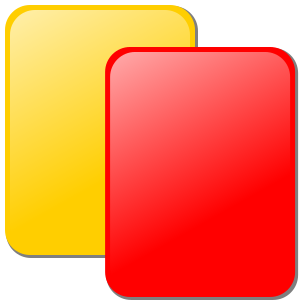
Okay, I’ve got to admit — I’m writing this post as much for my benefit as for yours. I never used to even know that there were penalty cards in volleyball. I hear “yellow card” and if I don’t think of that pop band with the violin, I think soccer. And I don’t really know the first thing about soccer, that’s just the association that I make mentally.
But, to be sure, volleyball has penalty cards, too (and so do more than a dozen other sports). They’re not as common as they are in soccer, for some interrelated reasons. Play is not continuous in volleyball like it is in soccer, which allows ample time for simple verbal warnings for trifling ‘offenses’ that don’t merit (or don’t yet merit) further recognition. I’ve also seen it said that volleyball intentionally tries to have a higher level of decorum, less salacious than soccer. Don’t know if there’s really anything to that, but it’s a sound argument considering you could go an entire season without seeing a yellow card. I’m pretty sure I did as a PA announcer.
The rules are slightly different for penalty cards whether we’re talking about college or international volleyball. For college volleyball, a yellow card is essentially a formal warning. It’s not given out without prior verbal warnings, at least to players and head coaches. Squawking from assistant coaches is much less tolerated, and could easily result in a yellow for a first offense. There is no immediate sanction for a yellow card in college volleyball; rather, it informs the party to whom the card has been assessed that he or she is essentially on notice. That no further complaining or bad sportsmanship will be tolerated. This is essentially the same rule for yellow cards in beach volleyball. Yellow cards can also be assessed for delaying tactics, as I reported in one of the matches I called this season.
In the international game, though, yellow cards do carry an immediate penalty, that being loss of rally and, if applicable, serve.
And that penalty is enforced for red cards in college and beach volleyball. Red cards are a step beyond warning, leading to an automatic sideout (if applicable) and loss of rally. I’m not sure why they would ever be enforced on a team that just won the last rally, though, so the penalty is a little redundant. It’s possible to have it happen before a match or set even begins, though, if a team is severely late coming to the court from the locker room or from a timeout.
Red cards are assessed for flagrant misconduct that’s understandably pretty rare in matches played above the club or pickup level. I have never seen a red card assessed in a volleyball match (only a handful of times have I seen yellow), and it’s possible I never will. They’re reserved for things like persistent profanity/verbal abuse from coaches or players (and it doesn’t necessarily have to be directed at the officials…it can even be a coach’s verbal abuse to his own players), threats or acts of physical violence or vandalism (I saw a report of a player getting redcarded for grasping and violently shaking the net after a call went against her) or other flagrant disrespect for the rules of the game and basic decorum.
Just like in soccer, two yellows make a red, but an individual does not have to first be given a yellow card in order to receive a red. Also, in college volleyball, carding resets at the beginning of each set, so a coach or player could in theory get five yellow cards without incurring any actual sanction.
The penalty for a red card in international volleyball is expulsion from the set. The offending player must not sit on their player’s bench for the duration of the set, either. I’ve seen descriptions of a ‘penalty area’ by the scorekeeper’s table for naughty boys or girls who get redcarded. If the team cannot legally substitute a player who is removed from a set for being redcarded, they forfeit the set. I can’t imagine why that would ever happen, though. In beach volleyball, if a player is assessed a red card, his or her team automatically loses the last rally (and serve, if applicable), but since there are no substitutions anyway in beach, that’s the end of it.
This same penalty exists in the college game if a player or coach is assessed yellow and red cards simultaneously. Yellow and red held in the same hand mean the individual is removed from the current set. Yellow and red held in opposite hands is the most severe penalty, indicating that the individual is disqualified from the entire remaining match, and must vacate the bench area within one minute or else his or her team automatically loses the entire match. The individual also must not enter the spectator area. International volleyball has yellow and red in the same hand as its harshest penalty; yellow and red in opposite hands doesn’t exist at the international level. All of these penalties also carry automatic loss of rally and serve.
You might go your entire life without seeing any of these sanctions actually enforced during a volleyball match. Even yellow cards are relatively rare, meaning that when people get them, they know it’s time to shape up or ship out. Which is an easy call. Hopefully this post was successfully able to clear up any confusion about volleyball’s penalty cards. You can look smart if the topic ever comes up in conversation at a match 😉
Add The Sports Daily to your Google News Feed!